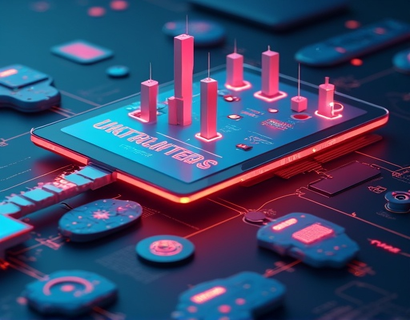Revolutionizing Engagement in the Digital Ecosystem: The Synergy of AI and Crypto
The intersection of artificial intelligence (AI) and cryptocurrency (crypto) is creating unprecedented opportunities for digital engagement and innovation. As the crypto ecosystem continues to evolve, integrating AI-driven strategies becomes essential for tech-savvy enthusiasts and digital innovators aiming to enhance their presence and maximize impact. This guide delves into the transformative power of AI in the crypto space, focusing on smart marketing solutions that are redefining how users interact with digital assets and blockchain technology.
Understanding the Role of AI in Crypto
AI technologies, including machine learning, natural language processing, and predictive analytics, are revolutionizing various aspects of the crypto ecosystem. These technologies enable more efficient, secure, and user-friendly interactions with digital currencies and blockchain-based applications. For instance, AI algorithms can analyze vast amounts of market data to predict price movements, optimize trading strategies, and identify potential investment opportunities. This data-driven approach provides users with actionable insights, enhancing their decision-making processes.
Moreover, AI-powered chatbots and virtual assistants are transforming customer support in the crypto space. These AI-driven tools offer 24/7 assistance, answering common queries, guiding users through complex processes, and providing personalized recommendations. This not only improves user experience but also reduces the workload on human support teams, allowing them to focus on more strategic tasks.
Enhancing User Engagement through AI-Driven Marketing
In the highly competitive crypto market, standing out requires innovative marketing strategies. AI-driven marketing solutions are at the forefront of this revolution, offering tailored approaches to engage users effectively. One of the key benefits of AI in marketing is its ability to create highly personalized experiences. By analyzing user behavior, preferences, and interactions, AI can deliver targeted content, recommend relevant products, and optimize advertising campaigns. This level of personalization increases user engagement and fosters stronger relationships between crypto projects and their communities.
Another significant application of AI in crypto marketing is sentiment analysis. By monitoring social media, forums, and other online platforms, AI can gauge public sentiment towards specific cryptocurrencies or projects. This real-time data helps marketers adjust their strategies to capitalize on positive trends or mitigate negative perceptions. Sentiment analysis also aids in crisis management by identifying potential issues before they escalate, allowing for proactive measures to maintain brand reputation.
Smart Marketing Solutions for Next-Gen Apps
For developers and innovators looking to launch successful crypto applications, integrating AI-driven marketing solutions is crucial. These solutions not only enhance user engagement but also drive adoption and retention. One such solution is predictive analytics, which uses historical data to forecast user behavior and market trends. By leveraging these insights, developers can refine their app features, optimize user journeys, and launch targeted campaigns to attract and retain users.
Additionally, AI-powered content generation can significantly reduce the time and cost associated with creating high-quality marketing materials. AI algorithms can generate compelling copy, design visually appealing graphics, and even produce video content tailored to specific audiences. This efficiency allows teams to focus on strategic initiatives while maintaining a consistent and engaging content flow.
Case Studies: Successful AI-Driven Crypto Projects
Several crypto projects have successfully harnessed the power of AI to enhance user engagement and drive growth. One notable example is a decentralized finance (DeFi) platform that implemented AI-driven risk assessment tools. These tools analyze user transactions and behavior to identify potential fraud and ensure the security of the platform. As a result, user trust increased, leading to higher adoption rates and a more robust community.
Another example is a non-fungible token (NFT) marketplace that utilizes AI for curated content recommendations. By analyzing user preferences and browsing history, the platform suggests unique NFTs that align with individual tastes. This personalized approach not only enhances user experience but also drives sales and increases user retention.
Building a Robust AI-Crypto Ecosystem
Creating a robust AI-crypto ecosystem requires a multifaceted approach that involves collaboration between developers, marketers, and users. Here are some key strategies to consider:
- Data Integration: Combine data from various sources, including blockchain transactions, social media interactions, and user feedback, to create a comprehensive view of user behavior and market trends.
- Continuous Learning: Implement machine learning models that continuously learn from new data, adapting to changing market conditions and user preferences.
- Transparency and Trust: Ensure that AI-driven decisions are transparent and explainable to build trust among users. This is particularly important in the crypto space, where trust is paramount.
- Community Involvement: Engage the community in the development and refinement of AI-driven solutions. User feedback is invaluable in identifying areas for improvement and ensuring that the tools meet real-world needs.
By focusing on these strategies, developers and innovators can create AI-crypto solutions that not only enhance user engagement but also contribute to the overall growth and stability of the digital ecosystem.
Future Prospects: The Role of AI in Shaping the Crypto Landscape
The future of the crypto ecosystem is deeply intertwined with the advancements in AI technology. As AI continues to evolve, we can expect even more sophisticated tools and applications that further revolutionize the way users interact with digital assets. One exciting area is the development of autonomous trading bots that can operate with minimal human intervention, executing trades based on complex AI algorithms. These bots can optimize portfolios, manage risks, and capitalize on market opportunities around the clock.
Another promising development is the integration of AI with quantum computing. Quantum computing has the potential to solve complex problems that are currently infeasible for traditional computers, including certain cryptographic challenges. AI can play a crucial role in developing quantum algorithms that enhance the security and efficiency of blockchain networks, paving the way for more advanced and scalable crypto applications.
Moreover, the rise of Web3 and the metaverse presents new opportunities for AI-crypto synergy. In these decentralized digital worlds, AI can facilitate immersive and interactive experiences, from virtual events to decentralized gaming. By leveraging AI-driven avatars, personalized content, and dynamic environments, these platforms can attract a broader audience and create new revenue streams.
Conclusion
The convergence of AI and crypto is transforming the digital ecosystem, offering unprecedented opportunities for engagement, innovation, and growth. For tech-savvy enthusiasts and digital innovators, embracing AI-driven strategies is essential to stay competitive and make a meaningful impact. By leveraging AI-powered marketing solutions, developers can create next-gen apps that not only enhance user experience but also drive adoption and retention in the crypto space. As the ecosystem continues to evolve, the potential for AI to shape the future of digital assets and blockchain technology is immense, promising a more connected, secure, and innovative world.










































